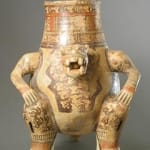Guanacaste-Nicoya Jaguar Effigy Vessel, 1000 CE - 1550 CE
Terracotta
PF.3221
Further images
-
(View a larger image of thumbnail 1
)

-
(View a larger image of thumbnail 2
)

-
(View a larger image of thumbnail 3
)

-
(View a larger image of thumbnail 4
)

-
(View a larger image of thumbnail 5
)

-
(View a larger image of thumbnail 6
)

-
(View a larger image of thumbnail 7
)

-
(View a larger image of thumbnail 8
)

This vessel is a typical example of Guanacaste-Nicoya Polychrome. It is appropriate to find an effigy vessel of a jaguar, displaying how the Costa Rican people worshipped this animal for...
This vessel is a typical example of Guanacaste-Nicoya Polychrome. It is appropriate to find an effigy vessel of a jaguar, displaying how the Costa Rican people worshipped this animal for its power and beauty. A perfect example of the strength of color use is seen on the head of the jaguar. The colors accentuate the most important aspects of the jaguar such as the big eyes, sharp teeth, and powerful muscles. Within the mouth of the jaguar there is a clay ball, transforming this vessel into a rattle most probably used in ritualistic ceremonies. The mouth of the jaguar exemplifies the power of the animal because, the jaguar shows us his sharp teeth, and at the same time gives us a jovial grin. Around the jaguar's head there is a very vibrant pattern of smaller jaguar heads. These patterns are seen around the extremities .as well, suggesting the symbolic importance of the revered jaguar. The most admired animal is present twice, once as a three dimensional head and the second time covering most of the body. The symbolism and strength of this work of art is felt through the vibrant colors, sharp lines, and patterning of the jaguar heads.







